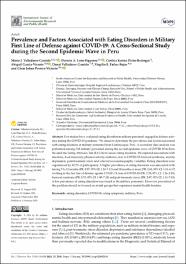Mostrar el registro sencillo del ítem
“Prevalence and Factors Associated with Eating Disorders in Military First Line of Defense against COVID-19: A Cross-Sectional Study during the Second Epidemic Wave in Peru“
| dc.contributor.author | Valladares-Garrido, Mario J. | |
| dc.contributor.author | León-Figueroa, Darwin A. | |
| dc.contributor.author | Picón-Reátegui, Cinthia Karina | |
| dc.contributor.author | García-Vicente, Abigaíl | |
| dc.contributor.author | Valladares-Garrido, Danai | |
| dc.contributor.author | Failoc-Rojas, Virgilo E. | |
| dc.contributor.author | Pereira-Victorio, César Johan | |
| dc.date.accessioned | 2023-05-22T14:56:54Z | |
| dc.date.available | 2023-05-22T14:56:54Z | |
| dc.date.issued | 2023-02-06 | |
| dc.identifier.uri | https://hdl.handle.net/20.500.13053/8603 | |
| dc.description.abstract | “: Few studies have evaluated eating disorders in military personnel engaged in defense activities during the COVID-19 pandemic. We aimed to determine the prevalence and factors associated with eating disorders in military personnel from Lambayeque, Peru. A secondary data analysis was performed among 510 military personnel during the second epidemic wave of COVID-19 in Peru. We used the Eating Attitudes Test (EAT-26) to assess eating disorders. We explored associations with insomnia, food insecurity, physical activity, resilience, fear to COVID-19, burnout syndrome, anxiety, depression, post-traumatic stress and selected sociodemographic variables. Eating disorders were experienced by 10.2% of participants. A higher prevalence of eating disorders was associated with having 7 to 12 months (PR: 2.97; 95% CI: 1.24–7.11) and 19 months or more (PR: 2.62; 95% CI: 1.11–6.17) working in the first line of defense against COVID-19, fear of COVID-19 (PR: 2.20; 95% CI: 1.26–3.85), burnout syndrome (PR: 3.73; 95% CI: 1.90–7.33) and post-traumatic stress (PR: 2.97; 95% CI: 1.13–7.83). A low prevalence of eating disorders was found in the military personnel. However, prevention of this problem should be focused on at-risk groups that experience mental health burdens. “ | es_PE |
| dc.format | application/pdf | es_PE |
| dc.language.iso | eng | es_PE |
| dc.publisher | MDPI | es_PE |
| dc.rights | info:eu-repo/semantics/openAccess | es_PE |
| dc.rights.uri | https://creativecommons.org/licenses/by/4.0/ | es_PE |
| dc.subject | eating disorders; COVID-19; eating symptoms; military; Peru | es_PE |
| dc.title | “Prevalence and Factors Associated with Eating Disorders in Military First Line of Defense against COVID-19: A Cross-Sectional Study during the Second Epidemic Wave in Peru“ | es_PE |
| dc.type | info:eu-repo/semantics/article | es_PE |
| dc.identifier.doi | "https://doi.org/10.3390/ ijerph20042848" | |
| dc.type.version | info:eu-repo/semantics/publishedVersion | es_PE |
| dc.subject.ocde | 3.00.00 -- Ciencias médicas, Ciencias de la salud | es_PE |
Ficheros en el ítem
Este ítem aparece en la(s) siguiente(s) colección(es)
-
SCOPUS [380]


